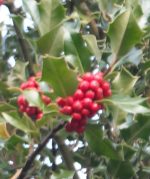 English holly is a broadleaf evergreen tree or shrub growing 15-20’ tall. It has attractive glossy dark green leaves with sharp spines on the edges and red to yellow berries in winter produced by female plants. This is the holly that has been associated with Christmas for centuries. It is native to the British Isles, southern, central and western Europe, and southwest Asia where it grows in oak forests. It has been grown in the Pacific Northwest as a landscape plant and commercially for the floral industry but has naturalized and become invasive as it forms dense thickets that shade out the native trees and shrubs. USDA Hardiness Zones 6-9
English holly is a broadleaf evergreen tree or shrub growing 15-20’ tall. It has attractive glossy dark green leaves with sharp spines on the edges and red to yellow berries in winter produced by female plants. This is the holly that has been associated with Christmas for centuries. It is native to the British Isles, southern, central and western Europe, and southwest Asia where it grows in oak forests. It has been grown in the Pacific Northwest as a landscape plant and commercially for the floral industry but has naturalized and become invasive as it forms dense thickets that shade out the native trees and shrubs. USDA Hardiness Zones 6-9
The following natives are recommended as alternative species:
Hairy Manzanita (Arctostaphylos columbiana)
This evergreen shrub forms a large dense mound with foliage all the way to the ground. It has small elliptical blue green leaves, terminal clusters of white to pink bell-shaped flowers, and red berries that persist into winter. Native to open woods,chaparral, and outcroppings from British Columbia to California. USDA Hardiness zones 8-9
Pacific Madrone (Arbutus menziesii)
A tall evergreen tree, Pacific madrone is up to fifty feet tall and has cinnamon-colored exfoliating bark, glossy green leaves that turn burgundy to yellow before dropping in the spring, and sprays of white bell-shaped flowers in spring followed by bright red berries. Trees are native to open woods, stream banks, and outcroppings from British Columbia south to Baja California. USDA Hardiness Zones 7-9
Wild Lilac (Ceanothus spp)
Also called California lilac, most species are evergreen shrubs but a few are small trees. One of the most popular, C. thyrsiflorus, has clusters of beautiful blue flowers in spring and early summer, and is native to open woods and chaparral in coastal mountains from Southern California north to southern Oregon. Its USDA Hardiness zones are 7-10
Tan Oak (Lithocarpus densiflorus)
This evergreen shrub or small tree has large elliptical dark green toothed leaves with pinnate venation and terminal clusters of small creamy white male flowers in late spring and summer. It is native to dry, rocky slopes and chaparral in Oregon and California and is hardy in USDA Hardiness Zones 7-10
California Coffee Berry (Rhamnus californica aka Frangula californica)
Native to California, southwestern US and Baja California, this large evergreen shrub grows in open woodland, brush canyon sides, and chaparral. It has shiny dark green leaves and young stems with a reddish tinge. Although the flowers are not ornamentally important, the green to red and purple berries add interest over several months. Hardiness Zones 7-10